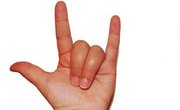The sign languages used in Canada are American Sign Language or ASL and a less commonly used sign language, Langue des signes québécoise or Langue des signes du Québec, which is known as LSQ. This is based on ASL and French Sign Language. Sign language is fun and exciting and relatively easy to learn. Each of these can fall under the umbrella of "Canadian Sign Language."
Maybe you have a relative, friend or student who is Deaf. Or you might just find the language interesting and challenging. Whatever your reasoning is, learning Canadian Sign Language will allow you to converse with those who use sign language, especially members of the Deaf community. Either by following the steps, enrolling in Canadian Sign Language courses online or in-person Canadian Sign Language classes, you can pick it up in no time!
The first step of Canadian Sign Language for beginners is to learn the signs for the letters of the alphabet, and practice until you have them memorized. While many signs are unique and specific for a word, many words do not have a sign. Finger spelling fills the gaps by allowing you to spell out the word you need.
Practice spelling simple words, like "cat", working on making your transitions from one letter to another smooth and precise. Add more complex words as you improve. Numbers are also important to learn in the beginning. Numbers are used frequently and you will do well to know them by heart. Remember not to bounce or move your hand too much when finger spelling. It makes it easier to understand.
Memorize signs starting with the 100 most common ones. Signing is largely about vocabulary. Fortunately, a few words can get you pretty far. Build a good vocabulary to help you be more expressive and concise. The more signs you know, the better a signer you will become.
Ensure that you understand and are using the parameters of each sign correctly. Signs are composed of basic parameters; hand shape, palm orientation, location, movement and non-manual signals.
Therefore, use:
- Proper hand shape. Hand shape is usually the most obvious parameter. When a sign is formed by the hand, it is defined by the shape that corresponds to the most similar letter.
- Proper palm orientation. Palm orientation is how the sign faces, whether out or in, up or down, or left or right.
- Proper location. Location indicates where the sign is formed in relation to the body. Use the proper movement and direction. Movement often helps define the meaning of a sign. Directional gestures can indicate to whom, what or where a specific sign is related.
- Proper non-manual signs. Non-manual signs such as facial expression and body position convey emotional and characteristic aspects of a sign, giving more depth and specific meaning.
Learn the grammatical structure. Like any other language, sign language has a specific grammatical structure.To remember the grammatical structure, think of TOSV: time, subject, object, verb. Here's an example. Suppose you want to say, "I'm going to the store now." In sign language, the structure for this sentence is: now (time) store (object) I (subject) go (verb).
Practice reordering spoken language into sign language structure in your head. As you become more proficient, you will also learn how to express plurals, to ask questions, to sign directionally and more to enhance your signing. Remember that sign language is also about function and economy of movement. Always be as direct and clear as possible.
Use your signing space effectively. The space is an imaginary frame just in front of you that extends from the top of your head to your waist and from just outside your left shoulder to outside your right. It provides an active area for viewers to focus. Work at staying within the signing space to make your signing is understandable.
Practice using not just your hands, but your arms, facial expressions and even posture and body position to tell the story. Remember that it is an expressive language. Don't worry about being expressive in the beginning. You will become more familiar and comfortable with these techniques later.
Along with this, illustrate for your audience. Sign language is visual. For a Deaf person to appreciate truly what you are saying, it helps to use signs that paint a picture in their mind. The more visual you can be the better.
Learn common phrases. Phrases like "Your name what?" or "You live where?" or "ASL I learn." may seem simple, but they can start more in-depth conversations that will help you practice your signing skills.
If you are learning with a partner, practice "voice off" for an hour each day. This will force you to remember signs and structure and express yourself, so the other person understands you.
Talk to the Deaf. There is no better way to learn a language than to talk to a native speaker. "Face-to-face interactive instruction from a native ASL signer is certainly to be preferred...," states Bill Vicars, professor of ASL and Deaf Studies at California State University.
Seek others who sign. Does your town have a school for the Deaf? See if you can volunteer there. Check for ASL clubs or Deaf community organizations in your area. Or, simply introduce yourself to deaf people you may see in your community. Most Deaf will be interested in why you are learning sign language and will want to know all about you. It's a great place to practice and get to know the Deaf community.
Continue to study and learn. As with any language, learning to sign is a life-long pursuit. You will always be adding to your understanding. Once you get good, you can consider teaching it to your friends and children.
Tip
Keep notes about signs you may see. Describe them visually, so you can look them up later.
Online and printed resources for learning Langue des signes du Québec are limited. If you would like to learn this language, we recommend contacting your local college or university for more information about resources in your community.
Warning
Don't allow yourself to get frustrated. Sometimes as you learn a new language, you will feel as though you are not progressing. You will hit plateaus and valleys. Don't give up. As time goes by, you will feel more and more capable with the language.
Related Articles
Tips
- Keep notes about signs you may see. Describe them visually, so you can look them up later. Online and printed resources for learning le Langue des Signes Québécoise are limited. If you would like to learn this language, we recommend contacting your local college or university for more information about resources in your community.
Warnings
- Don't allow yourself to get frustrated. Sometimes as you learn a new language, you will feel as though you are not progressing. You will hit plateaus and valleys. Don't give up. As time goes by, you will feel more and more capable with the language.
Writer Bio
In Jacksonville, Fla., Frank Whittemore is a content strategist with over a decade of experience as a hospital corpsman in the U.S. Navy and a licensed paramedic. He has over 15 years experience writing for several Fortune 500 companies. Whittemore writes on topics in medicine, nature, science, technology, the arts, cuisine, travel and sports.










